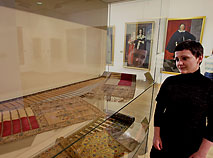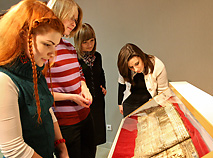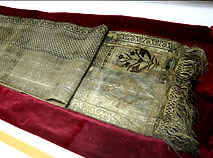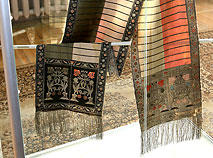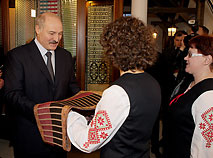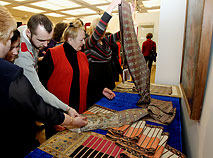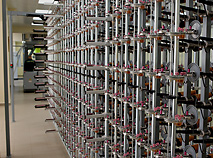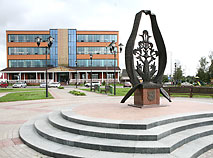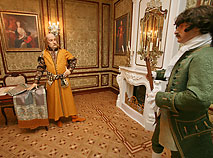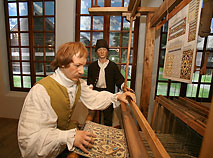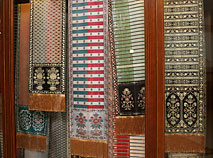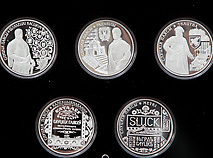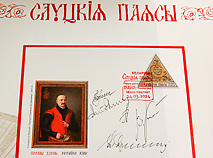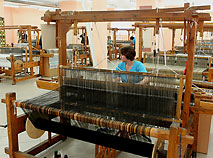Slutsk Belts
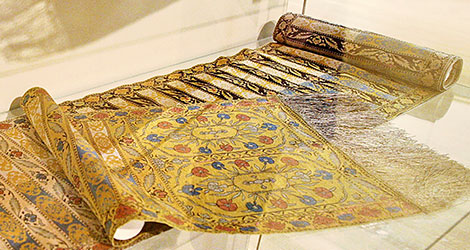
The famous Slutsk belts are among Belarus’ national treasures, a fine example of decorative and applied art. They have become not only a historic and cultural symbol but also a modern brand of Belarus.
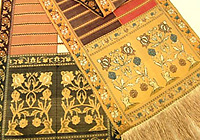 Only noblemen could afford wearing these exceptionally beautiful, symbolic and expensive belts. They were woven in Belarus since the 18th century. Amazing events and family secrets, mysterious and sometimes mystical stories are connected with them.
Only noblemen could afford wearing these exceptionally beautiful, symbolic and expensive belts. They were woven in Belarus since the 18th century. Amazing events and family secrets, mysterious and sometimes mystical stories are connected with them.
Today the original Slutsk belts are a rarity: Belarus has very few of these belts. A large part of them is kept in museum and private collections around the world.
However, Belarus has revived the unique traditions of making the Slutsk belts. Modern artists make their exact copies, analogues and artistic stylized designs, which can make an exclusive souvenir from Belarus.
Slutsk Belts: History of the National Symbol
Long, wide belts with beautiful patterns and complex weave-work from precious yarns became popular in the Belarusian lands in the 16th and 17th centuries. Their popularity was helped by the legends about the origin of the nobility of the Rzeczpospolita from the ancient bellicose tribes of the Sarmatians.
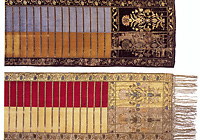 The belt in the attire of a noble man symbolized the belonging to the elite, the centuries-old family traditions and, of course, wealth. Expensive belts for the gentry were brought from Oriental countries. The unique artistic phenomenon "Slutsk belt" took shape in the Belarusian lands the 18th century.
The belt in the attire of a noble man symbolized the belonging to the elite, the centuries-old family traditions and, of course, wealth. Expensive belts for the gentry were brought from Oriental countries. The unique artistic phenomenon "Slutsk belt" took shape in the Belarusian lands the 18th century.
Belarusian weavers created their unique patterns and symbolic motifs, and devised their exclusive technology. The Slutsk Manufactory of the Radziwills, the richest and influential dynasty of Europe, became world famous.
The first belt-making manufactory was set up in Nesvizh, but in the 1750s Michal Kazimierz "Rybenko" Radziwill ordered to move it to Slutsk which was long famous for its skilful weavers.
The Radziwills invited the well-known master Jan Madjarski of Armenian descent who had worked in Istanbul, and Stanislawow. In 1777-1807, the manufactory was run by his son Leon.
In its heyday the Slutsk manufactory employed up to 55 weavers (only men!), 55 apprentices and spinners. Using 20-25 machines the manufactory annually produced around 200 belts of fine work.
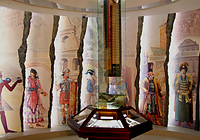 Very soon other factories started to copy the Slutsk belts: in Belarusian Grodno, Slonim, Ruzhany, Postavy, Korelichi, Shklov, Polish Kobylka, Lipkowie, Krakow, Gdansk, French Lyon, and in Austria...
Very soon other factories started to copy the Slutsk belts: in Belarusian Grodno, Slonim, Ruzhany, Postavy, Korelichi, Shklov, Polish Kobylka, Lipkowie, Krakow, Gdansk, French Lyon, and in Austria...
However, despite the sign "I was made in Slutsk", they were not genuine Slutsk belts. The production of authentic belts at the Radziwill’s manufactory continued into the mid 19th century.
It is believed that nearly 1,000 Slutsk belts have survived till the present day. Almost all of them are kept outside Belarus: in the museum collections of Poland (Warsaw, Krakow, Poznan, Gdansk), Ukraine (Kyiv, Lviv), Russia (Moscow, Saint Petersburg), Lithuania (Vilnius, Kaunas), in private collections.
Belarusian museums have 11 Slutsk belts of different years of manufacture and in different conditions, as well as numerous fragments.
Slutsk Belts: Features and Secrets
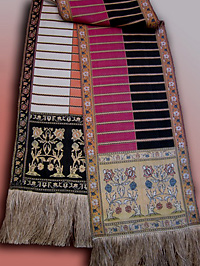 A classical Slutsk belt is a luxurious sash, 3.5-4m long and 35-40cm wide, which was worn folded or rolled up above the outer garment of the nobility (kuntush).
A classical Slutsk belt is a luxurious sash, 3.5-4m long and 35-40cm wide, which was worn folded or rolled up above the outer garment of the nobility (kuntush).
This classy accessory could be one-, two-, three- and four-facial. Each side was used depending on the colors of the outfit and the situation. For instance, the belt was put on with its golden, red side out on a holiday; the black side was used in mourning; green and grey parts were worn in everyday life.
The Slutsk belt can be divided into three parts: two rectangular endings ("heads") and the main part ("medium").
The "heads" contained floral patterns, intertangled stems with leaves, tree branches, medallions of different form. The main part consisted of lateral sole-colored or ornamented stripes. The belt sometimes had a fish scale or spotted patterns.
The belt had a narrow trimming with a floral ornament. The endings of the belt also had an ornamented stripe and strings.
The Slutsk belt was made of natural silk threads – ordinary threads and threads wrapped into a superfine golden and silver wire. Such a precious accessory was called "cast". The belt acquired unusual smoothness and magnificent glitter after it went through a special roller.
Slutsk masters put special marks on every belt they made. During the times of Rzeczpospolita these marks were in Latin. Later they were made in the Cyrillic alphabet: "SLUCK", "SLUCIAE", "SLUCIAE FECIT", "MEFECIT SLUCIAE" (I was made in Slutsk), "ВЪ ГРАДЪ СЛУЦКЪ"…
Modern Slutsk Belts
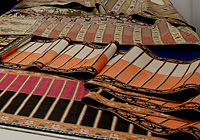 The Belarusian President adopted the Slutsk Belts Program for 2012-2015, which is aimed at reviving the Slutsk belts manufacturing technologies and promoting Slutsk belts souvenirs.
The Belarusian President adopted the Slutsk Belts Program for 2012-2015, which is aimed at reviving the Slutsk belts manufacturing technologies and promoting Slutsk belts souvenirs.
The program provides for the study of the history of Slutsk belts and their artistic qualities, the technologies that the Slutsk manufactory used for the production of authentic masterpieces, and the restoration of the belts under the modern conditions…
In 2012-2013 one of the largest Belarusian arts and crafts enterprises Slutsk Belts in the ancient city of Slutsk started to produce copies, replicas of Slutsk belts and souvenirs (panel paintings, accessories for books, telephones, and keys).
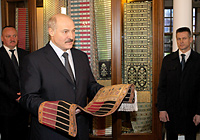 The enterprise studied the secrets of the weavers, qualities of the belts and the materials used for their production in the 18th century and recreated the unique technology.
The enterprise studied the secrets of the weavers, qualities of the belts and the materials used for their production in the 18th century and recreated the unique technology.
The first Slutsk belt – the exact copy of the original masterpiece – was presented to Aleksandr Lukashenko, and now it is kept at the Palace of Independence.
Today Slutsk weavers use natural silk, gold and silver threads, metallic embroidery threads, and metallic polyester threads. The belts have no analogues in the world.
The Slutsk Belts enterprise runs a unique museum where visitors can see modern belts, learn about the production process, and purchase souvenirs.
Slutsk manufactures a number of other traditional Belarusian products. For example, professional crafters weave beautiful tablecloths, napkins, Belarusian rushniks (towels) using hand-operated wooden looms.
Interesting Facts about Slutsk Belts
The famous Belarusian poem "Slutsk Women Weavers" by Maxim Bogdanovich is about bondmaids who weaved “the native cornflower bloom” instead of the Persian pattern. However, the story is nothing but a fiction, since only men, well-paid experienced professionals, had the right to weave the belts.
The founder of the famous Belarusian vocal and instrumental ensemble Pesniary, composer and singer Vladimir Mulyavin used the poem to create one of the most popular songs of the repertoire of the band.
Listen to the song
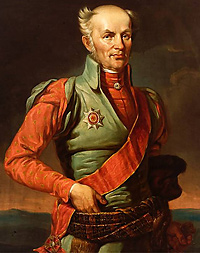 The authentic Slutsk belt could contain up to 200 grams of gold: in the old times such an expensive accessory cost as much as a couple of thoroughbred horses or a small estate.
The authentic Slutsk belt could contain up to 200 grams of gold: in the old times such an expensive accessory cost as much as a couple of thoroughbred horses or a small estate.
In 1939 the unique collection of Slutsk belts from the Nesvizh Palace was transferred to the State Art Gallery of Belarus. But at the beginning of the war all the masterpieces created by special order of the Radziwill family disappeared.
A nobleman wearing a Slutsk belt is depicted in the portrait of Wojciech Puslowski, the owner of the Kosava Castle. The painting was created by the talented artist Walenty Wankowicz.
The Slutsk belts patterns were used in the design of the lamp posts along the famous Independence Avenue of Minsk. The lamp posts were designed by the pre-war Director of the State Art Gallery Nikolai Mikholap.


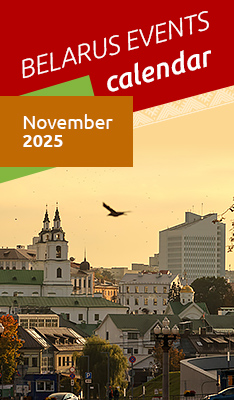




 print version
print version make home page
make home page add to bookmarks
add to bookmarks